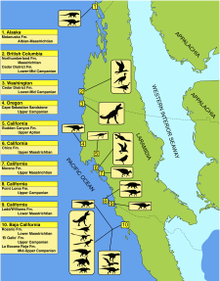Laramidia

Laramidia was an island continent that existed during the
Dakotas, and retreated toward the Gulf of Mexico and the Hudson Bay
. The masses joined, forming the continent of North America.
Laramidia is named after the Laramide orogeny. The name was coined by J. David Archibald in 1996.[1]
Geography
Laramidia stretched from modern-day
hadrosaurs, ceratopsians (including Kosmoceratops and Utahceratops[3]), pachycephalosaurs, and titanosaur sauropods are some of the dinosaur groups that lived on this landmass. A strong latitudinal climatic gradient existed on the landmass in the final 15 million years of the Cretaceous, helping drive regional provincialism of dinosaur faunas.[4]
Range
Vertebrate fossils have been found in the region from Alaska to Coahuila.[3][5][6][7]
Fauna
This section needs additional citations for verification. (February 2024) |

From the
Pleistocene ice age
. However, fossil beds which haven't been discovered yet could exist in areas of the former Appalachian continent.
In western North America during the Cretaceous the dominant theropods were the
Nanuqsaurus hoglundi,[8] Daspletosaurus, Teratophoneus, and theropods of Albertosaurinae such as Albertosaurus and Gorgosaurus, all being included under the same family of Tyrannosauridae
and not all contemporary. The bodies of tyrannosaurs exhibited huge heads and legs, in contrast to proportionally tiny arms. The teeth exhibited in this family are rather comparable to railroad spikes and would have helped inflict major damage on prey.
Another common group of North American dinosaurs were the
hadrosaurs
, the so-called "duck-billed" dinosaurs. The fossil record shows a staggering variety of hadrosaur forms in Laramidia.
Other differences in genera appear between the island land masses.
Nodosaurs, though, appear to have been more plentiful in Appalachia. Nodosaurs were large, herbivorous armored dinosaurs which lacked the giant club tail of their western relatives. They were scarce in Laramidia by the late Cretaceous, existing only in specialized forms like Edmontonia and Panoplosaurus
while nodosaurs were thriving in Appalachia.
References
- ISBN 023107624X.
- ^ "Amazing Horned Dinosaurs Discovered". MSN. 23 September 2010. Archived from the original on 2010-09-26. Retrieved 23 September 2010.
- ^ PMID 20877459.
- doi:10.1130/B35904.1. Retrieved 19 December 2022.
- ^ Rozell, Ned (10 February 2005). "Shedding light on Arctic dinosaurs, Alaska Science Forum, Article #1737". Geophysical Institute, UAF - Alaska Science Forum. Archived from the original on 2012-04-04. Retrieved 14 November 2011.
- ^ "Dinosaurs on Alaska's North Slope". Bureau of Land Management: Alaska. U.S. Department of the Interior. 30 May 2008. Archived from the original on 2011-11-10. Retrieved 14 November 2011.
- ^ Fernández, Hilda (3 October 2014). "Hallan en Coahuila cementerio de dinosaurios". El Universal (in Spanish). Mexico City. Retrieved 25 April 2015.
- PMID 24621577.
External links
 Media related to Laramidia at Wikimedia Commons
Media related to Laramidia at Wikimedia Commons











